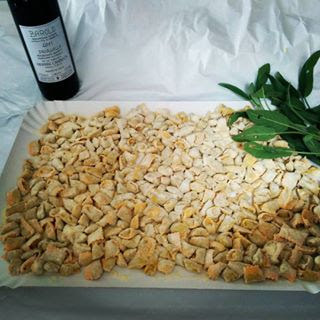 I am excited to announce that, in connection with a talented local chef from Barbaresco, the old train station of Barbaresco will play host to interactive cooking classes every Sunday afternoon during September, October and November. If you are looking for an authentic cooking class of local Piedmont dishes, look no further. I can also arrange a class based on the famed white truffle during truffle season. The idea was to create an accessible cooking class at a special location for individuals or groups to participate in, enjoy local cooking, share experiences and generally have a good time! The classes are run by a local Piedmont chef, and will focus on typical pasta dishes - tajarin (egg noodle pasta) and agnolotti del "plin" (stuffed pasta), together with the tricks of creating the best pasta sauces (think the famed ragu, or butter and sage or sugo d'arrosto). Other menu options may include risotto con tartufo, bonet (a delicious local dessert, made with eggs, milk, amaretti biscuits, caramel, all baked in a bain-marie). The classes will be held every Sunday afternoon starting from 10 September, through to 26 November, from 3:00 pm - 5:00 pm. The classes are for a minimum of 4 people, and are strictly limited to a maximum of 10 participants. We accept individual bookings also. The cost of the cooking class is EUR 50 pp. The classes include recipes, a glass of wine, cooking lesson with translation, and take-away pack of biscuits / pasta made on the day. I can also arrange a truffle hunt, paired with a cooking class based on local dishes for truffles. Cost of truffles will require a supplement, at market price. If you have kids, we can also arrange a special parents / kids cooking class, upon request. Release the masterchef within, and get your hands dirty (literally) and sticky! Bookings through [email protected], stating number of people and preferred date. The cooking class schedule is as follows:
16 Comments
It is somewhat of a pipe dream to one day go to Venice to celebrate Carnevale. The images are so beautiful, and I am besotted with the idea of dressing-up with an elegant mask and floating down the maze of canals. However, my dreams of Carnevale in Venice do not involve dragging around two little toddlers, so I may still have to wait a few years to realise that dream. In the meantime, I followed intently the social media feeds from the Venice carnevale. As an alternative, I heard about Carnevale di Viareggio in Tuscany, which is the oldest carnevale festival in Italy, dating back to 1873. It is held over a number of weeks, this year on 7 - 14 - 21 - 28 February and 5 March 2016. Perhaps (?) more child-friendly, it primarily involves a parade of a large number of allegorical papier-mache floats. Each parade march is concluded by a fireworks display. A 3-hour drive from the Langhe, and nestled on the Tuscan coast near Lucca, it is a relatively easy and feasible weekend trip. There is also the historical carnevale festival in Ivrea, in Northern Piedmont, which is famous for the orange-throwing events. One of our Piedmont bloggers wrote a detailed blog about this festival here. While I would certainly enjoy participating in this, it is not my idea of fun with two babes in tow... again, this might have to be parked until some time in the future... 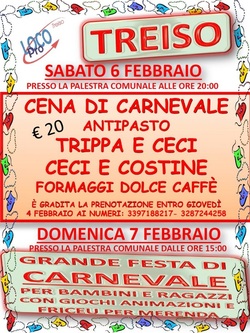 Finally, and as a local alternative, you can get involved in one of the local village mini-festivals of Carnevale. These are generally an excuse for the kids to get dressed up, and participate in fun-filled afternoon of activities. I went to one in Treiso, near Barbaresco, which seemed to me to be very well-organised and rather large. I think I can be satisfied with this one, at least for the next few years... This post is part of the #Blogpiemonte Group. Enjoy other blogs on carnevale here:
Another initiative by the talented Sandrone family of Barolo, held on the last Sunday on October (this year, 25 October 2015), is the 15th year of an annual event, featuring "tutta trippa". The event involves days of preparation, from sourcing and preparing the tripe, cutting vegetables, and logistical organisation. I interviewed Mariagrazia Sandrone, wife of dynamic Franco Sandrone, butcher of Barolo, in the lead up to the event, and got the low down on the features of this special tradition. Mariagrazia explained that the most important factor for both taste and quality, is to use the best tripe that has been hand washed and cleaned, without any bleaching. And how much do they use? Like all good food events, what started with humble beginnings in 2000 with a few pots of soup has grown to yield over 800kg of tripe. And to the tripe, they add chickpeas ('ceci') sourced from Nucetto, a local little mountain village in Piedmont. They also serve 'salami di trippa', a sort of terrine of tripe, sliced and served cold on crusty bread. As always, it is the quality and provenance of the primary ingredients which make the difference. There are other features of the event, such as local cheeses, salami and sweets, local music entertainers and of course Barolo from Barolo. But perhaps one of the most fascinating aspects of this event is the community involvement. The cooking of the prized and very traditional "zuppa di trippa" kicks off at 3 am in the morning, involving input from all the community to help stir the soup, with grappa or Barolo in hand to help. As I am writing this, I am getting ready to pull myself out of bed at 3am to go and help out and be part of the stirring crew.
Sometimes I am in Milan for work, and am invited to extraordinary events in the amazing city. Next week starts Milan fashion week (23 - 29 September), and associated with the week are a series of other events. Here is one coming up on the eve of Fashion Week, in case you need another good excuse over and above Expo to visit Milan, held in the cool Brera district.
VOGUE FASHION'S NIGHT OUT 2015 TARGAMY AND DOUBLE MALT PRESENT THE TARGAMY BRERA FESTIVAL The Targamy Brera Festival, as every year, is one of the leading events in the Brera district forming part of VFNO, to be held on 22 September in Milan, from 6 pm to 1am, in Piazza San Carpoforo-via Formentini-Brera, and includes the presence of 13,000 people who crowd the streets of the city and will be accompanied by spectacular scenery, exciting performances and entertainment. VFNO is an event organized by Vogue and dedicated to fashion and shopping, in collaboration with hundreds of stores that remain open late into the night to bring the public closer to the world of fashion but also with a social purpose. This year, the event will support research on cardiovascular disease in women at the Monzino Institute. Double Malt-communication company and organizer of young events, dynamic and enterprising, created by Chiara Giudici and Serena Biella-boasting, his press office as the trend setter Francesca Lovatelli Caetani, participates actively in the organization and management of the event Targamy the sponsors. Media partners: Radio 105 With: * Andrea Belli * DJ Flash (Dj) * Yves De Lacroix (Dj) * Marco Coccia (Dj) * Ary Fashion (Vocalist) * Fabiola (Vocalist) * Mark Evans (Singer) * Yegola (Pole dance) * Motion Revolution (Dance) * Titans + Warez (Robot) * Zampino (Wader) On stage, Red Bull and Red Bull Tour Bus will be organized a show that will include several artists Staff Targamy who will join those of Radio 105. For the after party will move at the Hollywood Club until 5:00. Corona is also participating in the event. Between 6pm and 1am in Brera will be delivered only by the staff of TARGAMY bracelets free entry to the after party PRESS OFFICE DOUBLEMALT FRANCESCA Lovatelli CAETANI 3200167747 [email protected] I always get asked for recommendations of where to stay in the Langhe. And I always give a similar response, so I decided to write a post on where to stay in the Langhe, to make it more efficient! The truth is that there are many, many amazing places to stay. Piedmont hospitality is second to none, and the choice, quality and service levels are vast. The first thing you need to decide is WHERE to stay. And by this I mean location according to your needs. 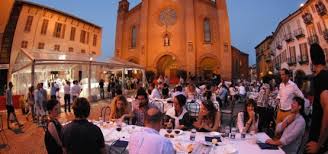 Options are: Alba, as bigger town, it's central hub. If you don't have a car, this would be pretty much your only option (or nearby Asti). In general I suggest that visitors have a car as the area is not really set up for public transport, and guided tours, while improving, are limited and can be expensive. It's more convenient to have your own car and explore the area at your own pace. In a little village: this is an attractive option, to indulge the Italian country life. Depending on your needs, if you select a little village, I would recommend one that has some amenities, like restaurants, bars, supermarket etc, so you have the option of forgetting the car and walking. Best villages in this respect would be: Monforte D'Alba, La Morra, Neive. In the countryside: for the quintessential Langhe lifestyle experience, I would recommend staying in a family-run place nestled in the vineyards. While the vineyards can be busy and noisy places at times (think tractors during pruning and harvest), otherwise, it is about as beautiful and relaxing as you could imagine. If you stay in the country, I would recommend a place that has a good restaurant attached, because it is always nice to have the option to eat well, drink better (you are, after all, in the heart of red wine country), not worry about driving and quietly retreat to your lodgings after, also with the remains of the wine bottle in hand.... 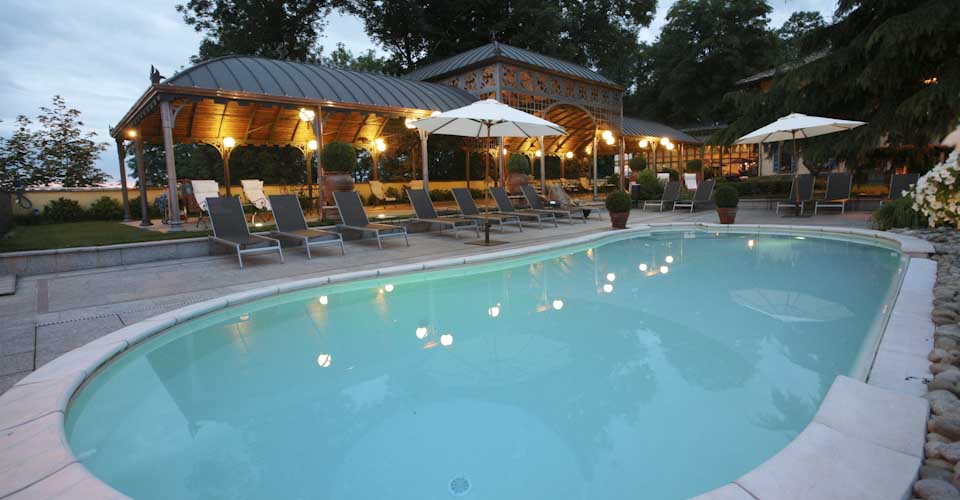 Villa Beccaris, Monforte D'Alba Villa Beccaris, Monforte D'Alba So, here are some suggestions within the three 'location' options for a range of budgets (although in general nothing is particularly cheap) and needs. Be warned, the Langhe is popular, particularly in the Summer months and truffle fair season (late Sep - mid Nov) and good places book early. Alba centre L'ortodellerose B&B ($$): beautiful B&B right in the heart of Alba, also on airbnb. Vincafe ($$): in the heart of the action, modern, well-equipped rooms, also possibility of self-cater apartment, but can be noisy and difficult to park. Hotel Calissano ($$$): just outside of historical centre, large well-appointed hotel with parking. Piazza Duomo rooms ($$$): elegant, quality rooms attached to Piazza Duomo three-Michelin star restaurant. La Morra Agriturismo Brandini ($$): modern but classic rooms in country side backed by Eataly and Joe Bastianich. La Morra / Novello Angolo di Rosina ($): fantastic, friendly, family-ran B&B with terraces, restaurant and great feel. Barbaresco Casa Nicolini ($): pool, great restaurant with stunning view, modest lodgings. Monforte D'Alba La Torricella Agriturismo ($$): pool, great restaurant, winery, top class operation. La Casa Gialla ($$): self-catered well-appointed apartments run by passionate couple. Villa Carusera ($$$): Luxury private villa for hire, in historical centre, with pool. Villa Beccaris ($$$): beautiful villa lodgings with cozy rooms, gardens and pool in centre of Monforte D'Alba, with car park. Beyond Alba (nearby Asti) La Villa Hotel (Casa Daina) ($$$$): beautiful estate, luxury rooms, if you want to splurge. On the last Sunday of November I had the pleasure of going to what I hope will be an annual event on my calendar – Bolliti di Barolo. What is Bollito? It is a classic Piedmontese dish of the winter months, and consists of a slow-cooked selection of mixed boiled meats served with traditional home-made condiments. This particular event is hosted and prepared by the talented butcher of Barolo, Franco Sandrone, in a big white tent opposite the butcher shop in the main street of Barolo. His luxury version of this classic consists of scaramella (veal plate / flank cuts), punta di petto (brisket), tenerone (literally big tender, neck to shoulder cut), cappello da prete (shoulder), muscolo della coscia (forequarter meat), lingua (tongue), coda (tail), testina (head of veal), gallina (chicken) and cotechino (cooked salami typical around Christmas). The day of the event happened to be a miserable rainy day, perfect to snuggle up inside with 200 of your closest friends and feast and be merry! And feast we did. The menu included antipasto of a terrine with local cheese raschera and cardi (which is a white thistle-like vegetable I have never seen elsewhere – it is used a lot in the Langhe cuisine and is beautiful raw, with bagna cauda, or cooked with egg and cheese). Then the star of the meal – the bollito, served with three sauces, salsa verde (green sauce made with parsley, anchovies, garlic, oil, boiled egg, bread soaked in vinegar); salsa rossa or bagnet russ in Piedmontese dialect (red sauce, made with tomatoes and garlic) and salsa tonnata (tuna sauce, made with mayonnaise, tuna and anchovies). Following the bollito, serving as a sort of palate cleanser, was the agnolotti del plin in brodo (filled pasta ‘pinched’ closed, cooked in the meat broth). And the pasta was incredibly all handmade with the tender love and care of the butcher’s wife, Mariagrazia Bozzoli and daughter, Martina Sandrone. And for dessert, Madernassa pears cooked in red wine and panna cotta. All this paired with local wines and digestifs – a great menu, all inclusive for EUR30. His bollito is clearly well-loved, and he seemed like a local superstar because every time he walked in and out of the tent he got a standing ovation. To complete the jovial atmosphere, there was a roaming band belting out Italian ballads, and some traditional Piedmontese classics.
All in all, a fantastic event, and great way to try one of the classic Piedmontese dishes of the winter. Looking for an authentic, family-run restaurant? Trattoria Del Peso in Belvedere Langhe, a tiny village in the Alta Langa (Upper Langhe), in Piedmont is the real deal. Run by the two Schellino brothers, Ezio as front of house and Mauro in the kitchen, this Trattoria has been run by the same family since 1948 and was started by the 'nonna' of the two brothers. It was originally started as just rooms, with the trattoria to feed guests. Now open only for lunch, the menu changes daily, and Mauro's philosophy is to provide a traditional-style menu of a string of tastes, but never too heavy or too much so that you could easily come back and eat there the next day. Clever. The Sunday menu is more extensive and elaborate than the simple weekday lunch, designed to allow a longer celebration of the dining occasion, whether it's a meal between friends or family or colleagues. 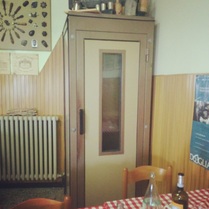 Decorated with gingham tablecloths, rustic glasses, an historical display of truffle slicers, cooking implements and vintage posters, to say this place oozes of traditional character is an understatement. Then there is an old telephone booth, in the corner, which was quite unbelievably occupied by an old lady for the first 45 minutes our lunch! This brown and completely soundproofed booth - I was told - operated as the town’s single public phone booth many years ago. If only the walls could talk… 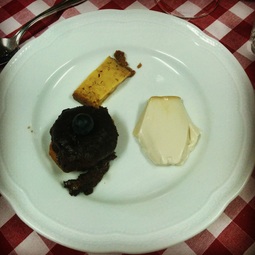 And the food was just as full of tradition, but with real character. We were there on a Sunday, and started with fresh figs with local Tuma cheese, delicate poached cod (merluzzo) with boiled potatoes, spicy breaded prawns on skewers, carne cruda (seasoned raw meat) topped with aromatic shaved black truffle, and crumbed fresh porcini. This was followed by agnolotti del plin (meat-filled agnolotti, pinched (‘plin’ in Piedmontese dialect)), and tajarin (egg noodle pasta) with porcini and black truffle, then roast lamb cutlets with prunes and fried semolina. The dessert platter was a sublime trio of pannacotta with a hint of coffee, budino (a traditional amaretto flavoured milk pudding) and pesche ripiene (poached peaches stuffed with chocolate and amaretti biscuits). True to Mauro's philosophy, the portions were not too big, so at the end of the meal you didn't feel like you had overeaten. Coupled with some great local wine (such as Del Tetto Favorita, Gillardi Dolcetto D'Alba and Moscato d’Asti) plus limoncello, grappa and coffee, it's the kind of place you can easily while away the day. There is also a ping pong table out the back in a sun-filled room, and an old wooden bar for coffee and digestifs. Attached to the restaurant is an alimentary store (tabaccheria), from which the perfume of truffles was emanating into the restaurant! A great, homey place. Will be back soon, maybe tomorrow!
It’s early morning near the end of summer in Monforte D’Alba. The fog is still lingering from the night before. It brings an eerie, almost mystical atmosphere. And I’m excited! I am doing a late summer truffle hunt this morning with one of my trusted truffle hunters, and his gorgeous dog. It was raining in the morning, and he calls to check that I’m ok to go out in the rain. Er, hello! I didn’t buy gumboots for nothing. I want the authentic experience (I never do ‘simulated’ truffle hunts). I ask – is it ok for the truffles? He says it’s fine for the truffles, so I say let’s go! And go we did…. in his old 4x4 fiat panda. These cars are purpose built – small and nimble, but with the 4x4 capacity necessary to navigate this hilly countryside. There is a lot of mud, and the car is slipping and sliding down a deep descent, surrounded by vineyards, into the little valley. I am a little scared but I feel alive! We arrive in a picturesque spot, where there is forest all around and small plantation of hazelnut trees. Out pops his canine friend, Cheetah, a brown and white curly-haired dog of almost 6 years. She is relatively young, and exceptionally well-trained and you instantly see the bond between truffle hunter and dog. He talks of her affectionately, and rightly so, as it is her ability which is critical in being able to sniff out these underground delights! He tells me this spot is relatively convenient and easy, but we are already jumping streams and ducking under foliage. (I’m interested to see the difficult spots!) But I am taken aback by the beauty of the woods – a very green and healthy collection of poplars, ivy, ground cover, and other very tall trees (oak, walnut etc). It’s all completely wild and natural, but you couldn’t have made it more attractive if you tried - an enchanted forest; all your childhood books blended into one experience. Even while we are chatting about life as a truffle hunter, he has a keen eye on his dog. She is pacing around the forest floor, eager to please and scope out the hidden gems. Suddenly, she gets excited and starts digging. Then stops and quickly comes back to the hunter for a treat. He tells us that she has learned this technique, of finding the truffle, but not digging too much, because when they come at night, and you can’t see, she sniffs out the truffle, comes back and tells her master where it is, and then together they go, with torch in hand to collect the prize. It’s obviously important, particularly with the more precious and delicate white truffle, that the dog doesn’t dig too close for fear of damaging the outer flesh. The more perfect-looking and intact is the truffle, the higher the pricetag. 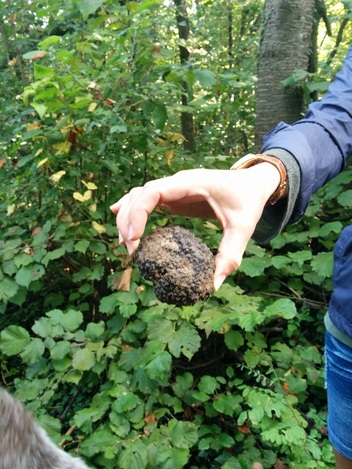 She has found a sizeable black truffle. It is the summer variety found in Italy between June and early September, not to be mistaken with another type of black truffle, sometimes also called ‘black truffle’ or ‘Perigord truffle’, which is a winter truffle, with darker flesh and white marbling. It is more highly prized than the summer black truffle, which has a paler, beige flesh. Neither of these, however, is as esteemed as the white truffle of Alba, found in the areas around Alba (the Langhe) and Asti. The season for the white truffle is from late September to January, but it depends of course upon the climactic conditions. For example, 2012 was too dry, and as a result, I am told, there weren’t many truffles, and the quality wasn’t good. Because of the scarcity, unfortunately this caused the price to skyrocket, although not because of the quality. In the height of truffle season the white truffle could fetch as high as EUR600 per 100g, although generally the price is more around EUR250 – 300 per 100g. 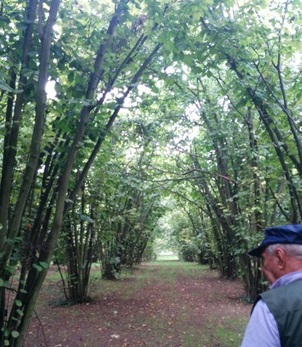 The truffle hunter tells me that he comes out two or three times a day (perhaps morning, after lunch and then during the night). This is because there is no way to know positively when the truffles will be ready. Evolutionary speaking, truffles (as an underground tuber) lost the ability to spread their spores through the air and instead rely upon fungivores (truffle eaters) to find the tuber for spore dispersion. That is why the sexual spores of the truffle have an attractive perfumed scent. But it seems that the precise point at which the sex spores are ready can be as elusive as the truffles themselves (is there no app for measuring this cycle??). As a result, he tells me that he sometimes goes over one section with his dog, and finds nothing, only to find truffles on the way back! With such uncertainty, and fine timing, it’s no wonder he comes three times a day or as often as he can. And for this, it is a job of real passion and patience. 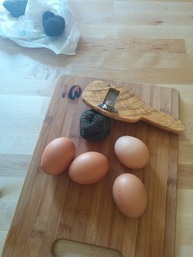 After a couple more location changes and a fair few more black truffles in tow, we finish up. And so how does one best enjoy these fine delicacies? The truffle hunter swears the best way to enjoy the white truffle is with egg, with the freshest white truffle of Alba generously shaved on top. He explains that you should never cook the white truffle because it loses its aromas. (Check out my blog post on Piazza Duomo, where I report on the best place to eat white truffle in Alba, IMHO.) A good day hunting? Perhaps - he says - but the epitome for our trifolau is in November or December, when it’s cold (possibly freezing as there can be snow) and he strikes gold and finds a big white truffle. It’s humbling to see a man of some years be so emotionally touched, still, by the search with his dog friend for the elusive white treasure. I organise real truffle hunt tours leaving from Monforte D’Alba from the months of June – January, conditions permitting.
Yep, this is a good blog subject, to read about and, let’s be honest, to do research on... I can't exhaust this question in just one blog post, as there are too many good options, and also it will leave me with no excuse to continue researching! So today I am writing about where I like to go for aperitivo in Monforte D’Alba, my home town. Stay tuned for more aperitivo hot spots... What exactly is aperitivo, you may ask? Italians think about food all the time. Even when they are eating, they are planning their next meal. So what do you do, after a big lunch, and a nap, but before you can think about dinner at 8pm (or 9pm, depending on how ‘European’ you are)? Cue aperitivo. It’s that idle time between nap and dinner time when Italians get to think about food again... over a drink. 'Nuff said. Here is a list of some of my regular places in Monforte D’Alba, depending on my mood. Moda: set in an old palace recently and decadently refurbished, aperitivo here makes you feel like a million bucks. And for only about 5 euros (depending on the wine), you get a good glass of wine or bubbles (various Italian choices and champagne too) and a beautiful array of upmarket snacks. When the weather is fine, you can sit outside, listening to the bubbling fountain in a beautifully manicured terrace overlooking Monforte village and the Alps on a clear day. A-mazing. 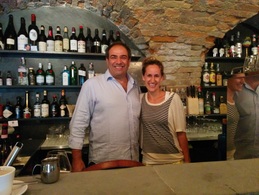 Me and Giulio at Saracca Me and Giulio at Saracca Saracca: in case you don’t want to opt for the palace, you can choose an old medieval castle instead! Just up the road from Moda, owner Giulio and bar chick Sara are the perfect hosts. There is a great range of wines by the glass and a huge smorgasbord of cured meats, cheeses, olives and various daily snacks. A great venue, and a great vibe, always, and particularly good for the cooler, winter months. Also, you can drink here until all hours, so think of it as a place for a night cap as well as an aperitivo! 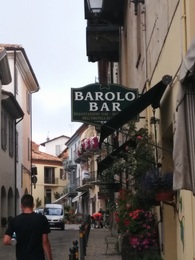 Barolo Bar: more of a local institution, located down a side street off the main piazza. In summer, they offer aperitivo on the terrazza, which is a beautiful open area opposite the bar upstairs. Drinks can be hoisted up with an old basket and pulley ‘system’. At the moment, on Wednesday nights they have live music (could be rock bands, DJs, Latino or acoustic). Again, an interesting array of wines and snacks, plus it is also a bottle shop, so if you like the wine you tried, you can take it home for dinner. 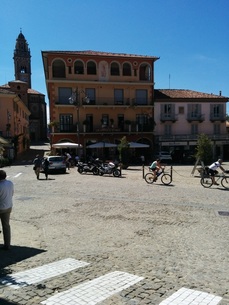 Grappolo D’Oro: another Monforte D’Alba institution in prime location, choose this place for people watching. Perch yourself in the main square of the bustling little village, and watch the people come and go. Plus, if you have kids, they can run around the piazza, if they are not otherwise being entertained / distracted by Italians (men, women and children alike) doting on them. Snacks are more limited – think bowls of chips and nuts. Locanda della Contessa Berta: a new comer, but a force to be reckoned with. Run by two young friends, Davide and Valentina, this is another good option for an aperitivo in the square, but from a different angle. I'm always looking for more aperitivo options (for research purposes, of course). Do you have a favourite bar for aperitivo?
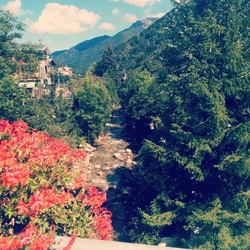 On the day before Ferragosto, the biggest holiday in Italy, our mission was to find a dairy farm in the mountains for our two little girls to see, and possibly milk, mountain cows. By chance, we stumbled across Agriturismo Agrifoglio, a cute agriturismo just 5 minutes out of Limone Piemonte, a picturesque mountain village in the French Maritime Alps. The food was simple but delicious, and we ate overlooking their cows (and a calf) grazing peacefully with a stunning mountain backdrop. One of the cool things about the Langhe is its proximity to a number of mountain ranges, the French Maritime Alps and Ligurian Alps (about 1 hour) and the Swiss Alps (2 hours). There are so many charming little mountain villages to explore, so where to begin? Limone Piemonte is immediately appealing - a gorgeous little village located in Col di Tende between the French Riviera and the Italian Riviera. At just over an hour and 15 min drive from the Langhe, it is a perfect day trip in the summer to get some fresh mountain air or in the winter for world class skiing. It is also a convenient mid way point on the back road between the Langhe and Nice (France). (I was interested in the role Its strategic location played in its history and found a good summary on the village's website.) The village itself is very attractive, with stone-built chalets and a chic feel, boutique shops and a wide range of restaurants, including both French and Italian, with a focus on mountain cuisine (think raclette, polenta). We could easily have eaten at one the many restaurants in the town, but given it was the day before Ferragosto, to say it was busy is a gross understatement.... So we ventured out of the town to seek out a mountain retreat, and we found Agriturismo Agrifoglio. 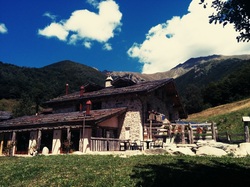 The Agriturismo was a great find - picture-perfect location, nestled within two imposing mountain ranges. The building itself appeared to have been recently renovated. It was tastefully decorated, but homey, with exposed stone vaulted ceilings, I can imagine it being stunning also in winter. And there were cows! Right on the grass out front of the restaurant, and one little calf. We were also lucky to find a cute puppy that needed a new home, but somehow we managed to resist taking him with us.... 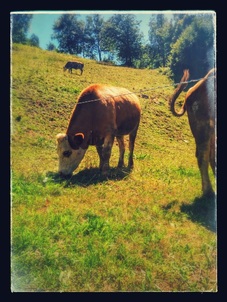 The restaurant at the agriturismo was the quintessential experience. There were two or three simple menus using their own or local produce, all inclusive for EUR25 for a plate of antipasti, a main meal (various grilled meat options, or polenta and cheese) and either cheese plate or dessert, together with coffee, water and digestive included. They also had a kid's menu of hamburger or pasta, drink and dessert for EUR10. The antipasti platter was impressive, with a nice mix of vegetables (fried green tomatoes, stuffed zucchini, fried zucchini flowers) and meat ('vitello tonnato' (poached veal with tuna sauce), herb-stuffed roll of rabbit, and house-cured 'lardo' on crostini with cheese). For main, I had the veal grill and the meat was so tender and the char-grilled flavours were sublime. And for dessert, there was a platter of three, the highlight being the stuffed peaches (poached peaches filled with amaretti biscuits and chocolate). A cut above, we will return, maybe in winter next time. |
AuthorEleanor Fletcher - living in the heart of the Langhe, Monforte D'Alba (Barolo). Searching for great eats, formidable drinks and fun times. Married to a Barolo and Barbaresco producer, plus a mother of two 'principesse'. Archives
August 2017
Categories
All
|
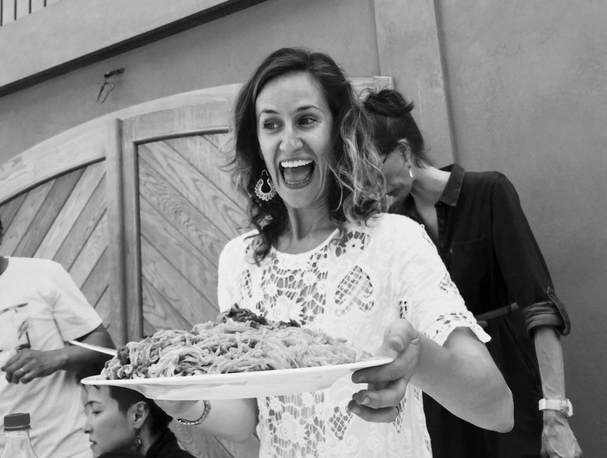
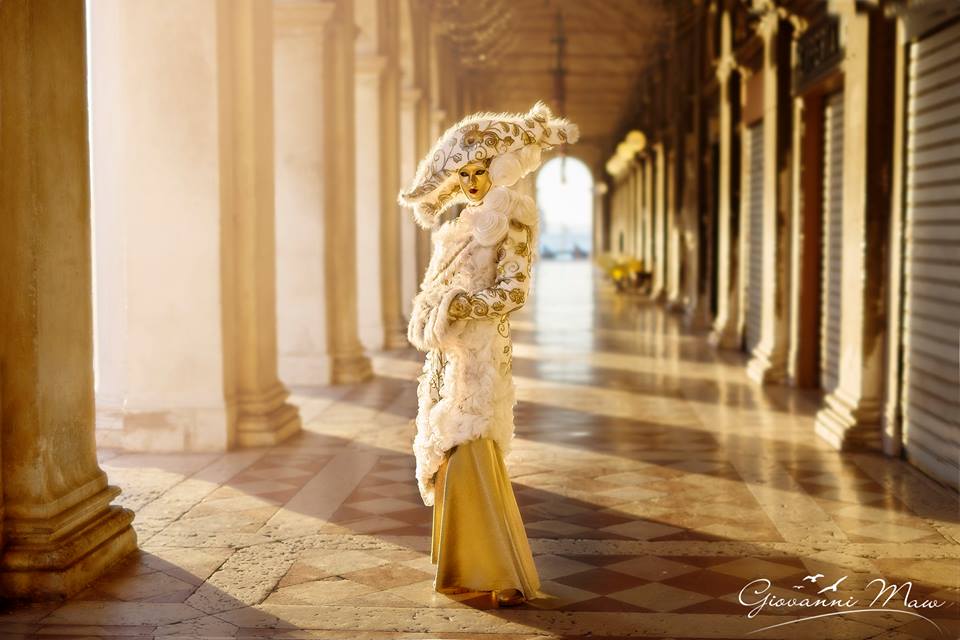
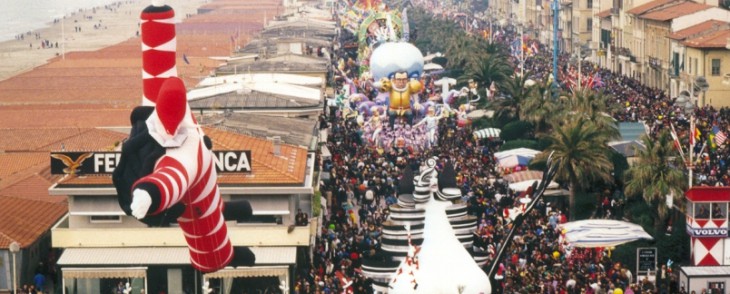
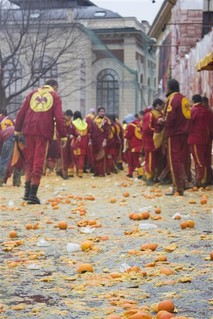
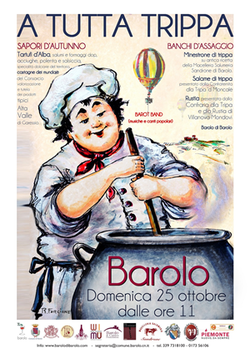
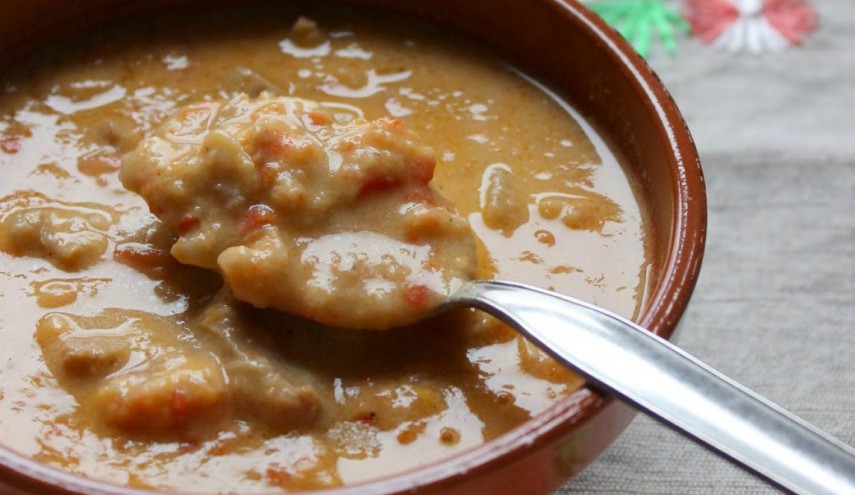
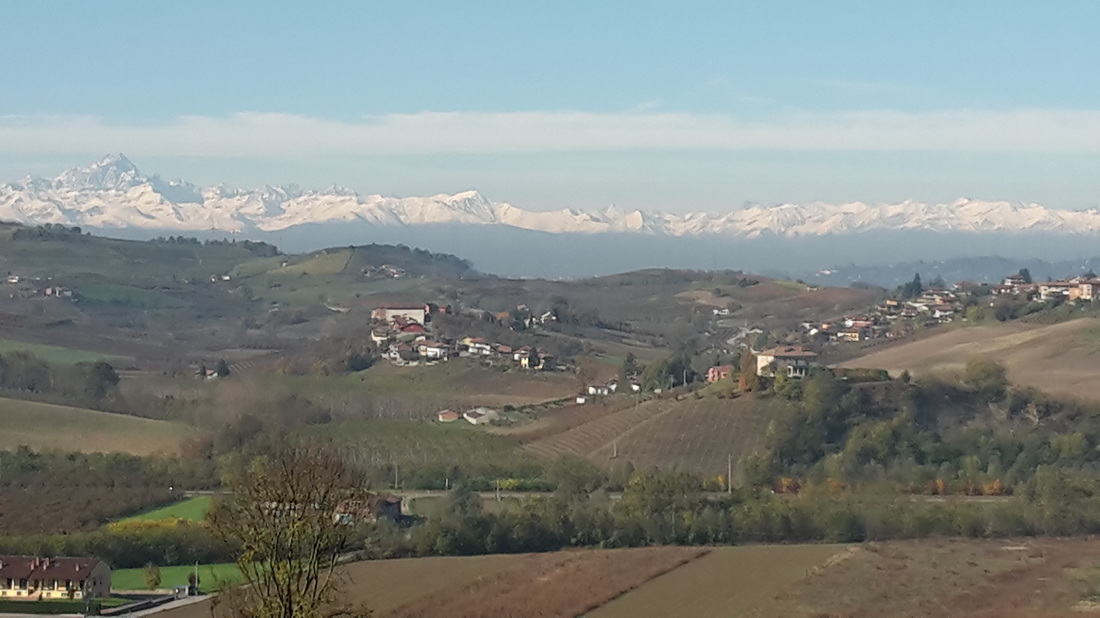
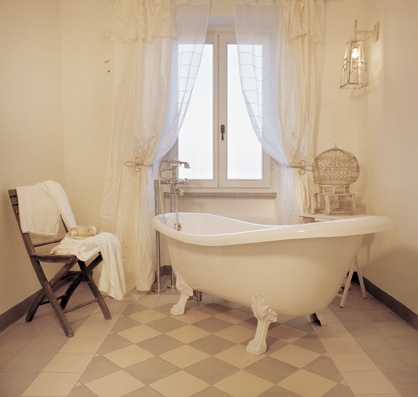
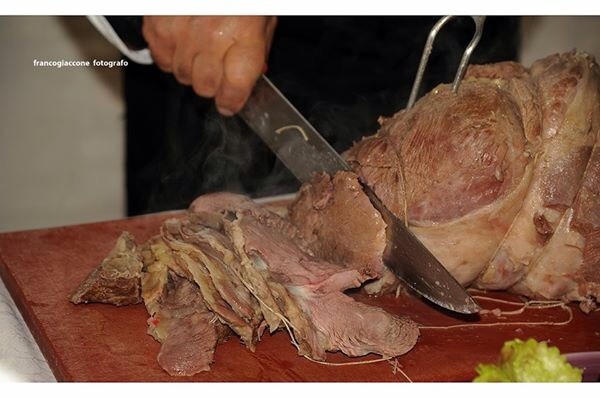
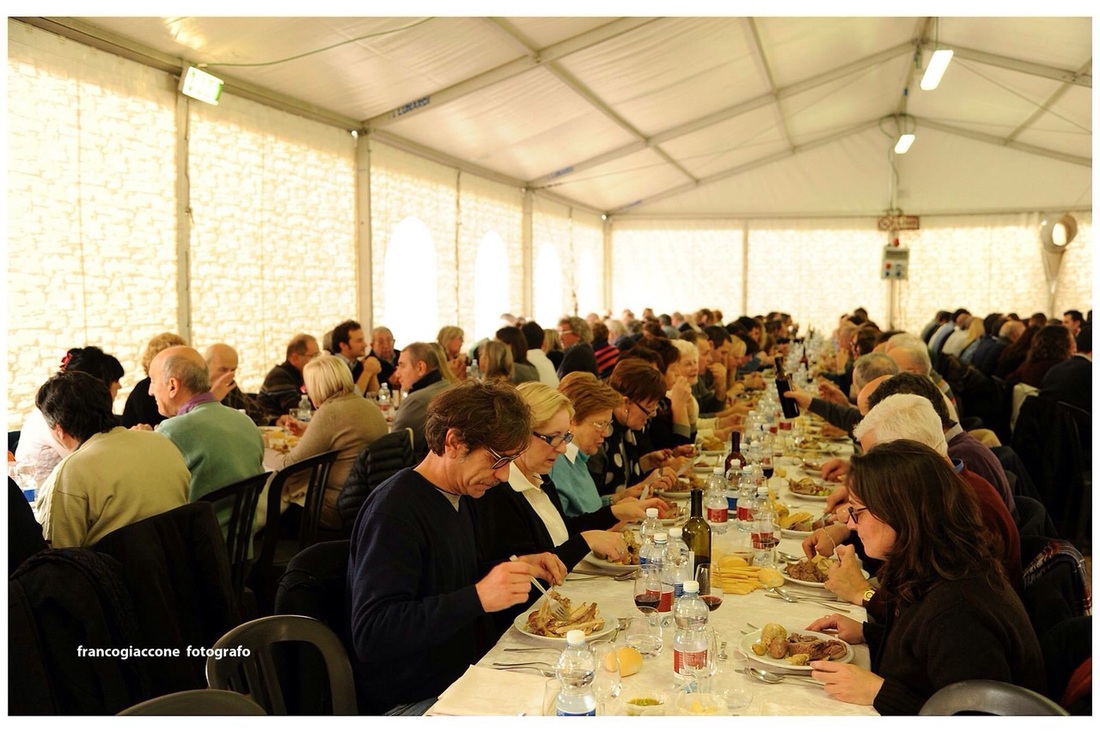
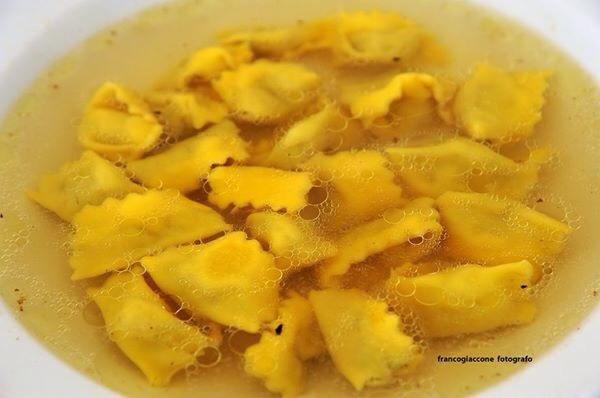
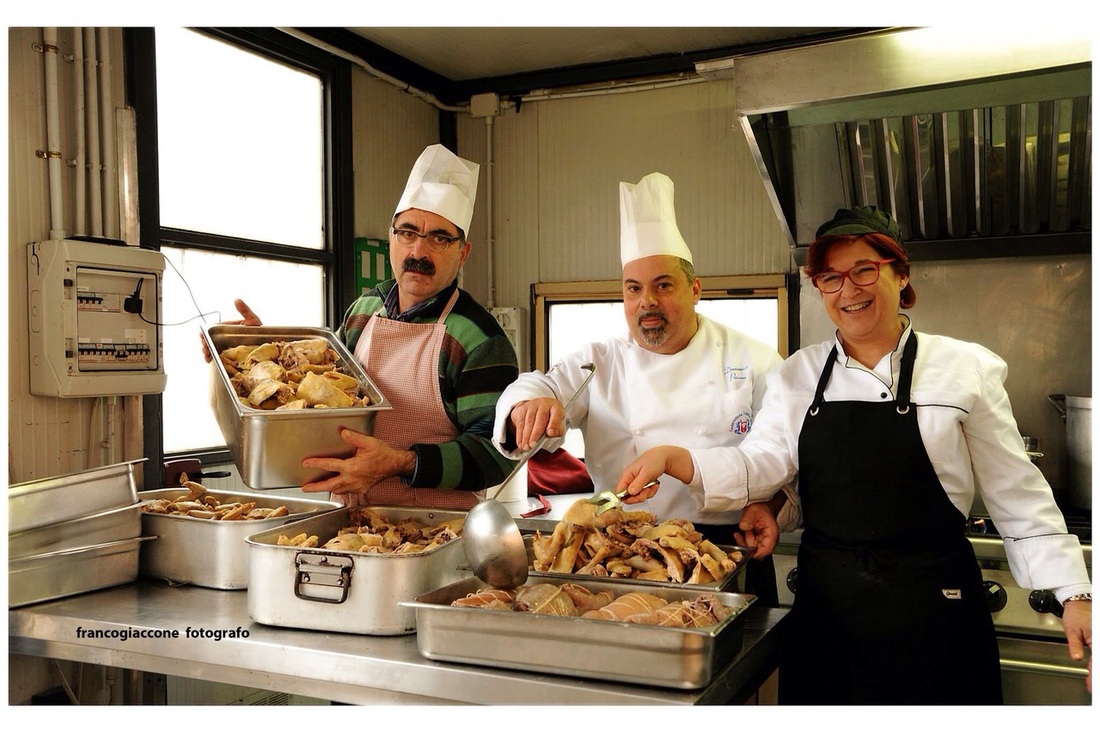
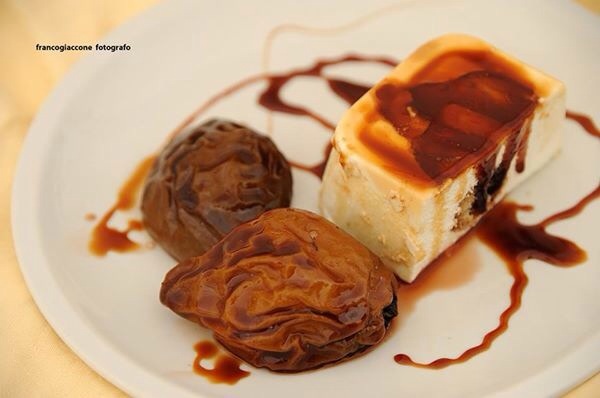
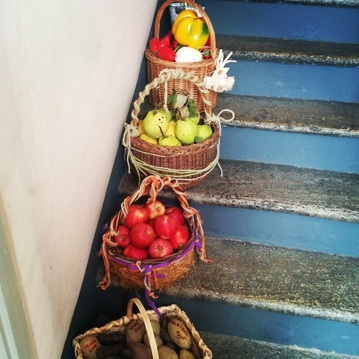
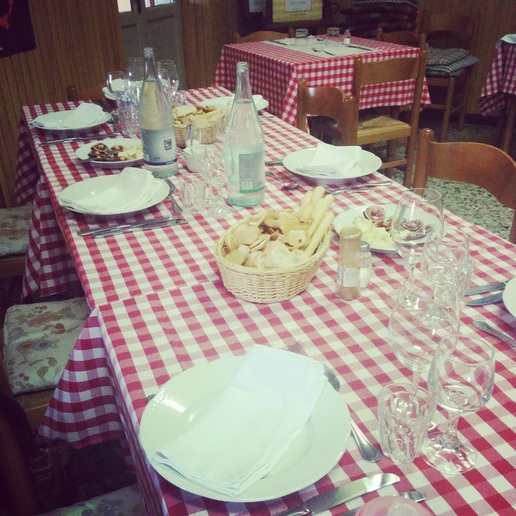
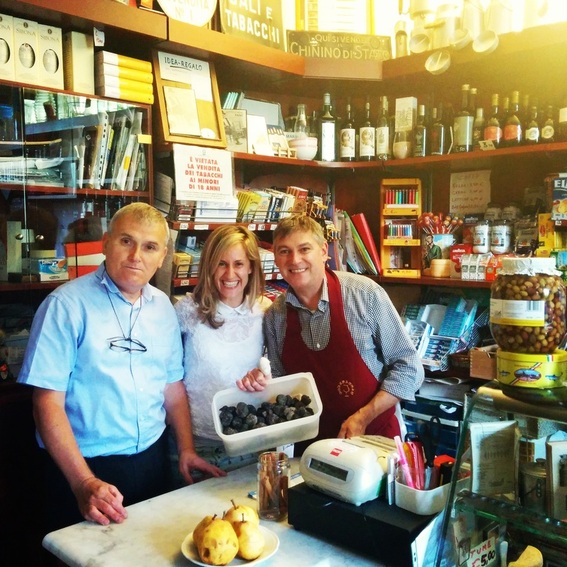
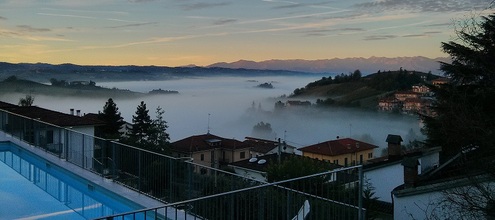
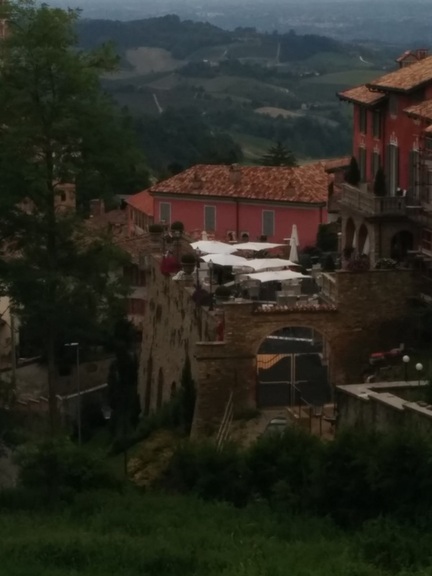
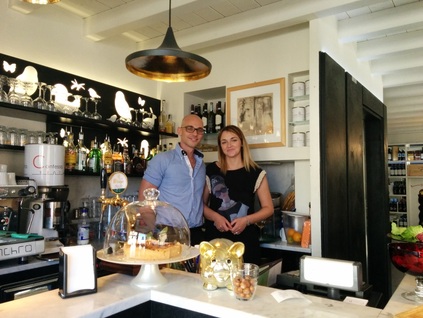
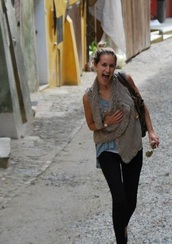
 RSS Feed
RSS Feed
